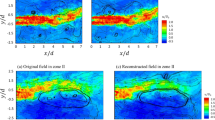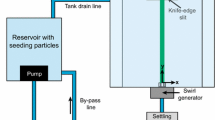Abstract
This study investigates the sensitivity to initial conditions of swirling jets undergoing vortex breakdown. Emphasis is placed on the recirculation bubble and on the helical coherent structures that evolve in its periphery. It is proposed that the vortex core size of the incoming swirling jet is the critical parameter that determines the dynamics of these coherent structures. This proposition is assessed with Stereo Particle-Image-Velocimetry (PIV) measurements of the breakdown region of two swirling jet configurations with different vortex core sizes at very similar overall swirl intensities. The swirling jets were generated by radial vanes entering a mixing tube, and the vortex core size was adjusted by using different center-body geometries. The time-averaged flow fields in the breakdown region reveal substantial differences in the jet spreading and the size of the recirculation bubble. Proper Ortogonal Decomposition (POD) was applied to the anti-axisymmetric and axisymmetric velocity fluctuations, to reconstruct the dynamics of the helical instability and the breakdown bubble, respectively. We find that the mode shape of the helical instability is not affected by the vortex core size. The frequency is found to coincide with the vortex core rotation rate, which relates inversely to the core size. The shape and dynamics of the non-periodic breakdown bubble are significantly affected by a change in vortex core size. The POD reveals that the energy content of the dominant non-periodic structure is changed markedly with the vortex core size. The bubble dynamics are further investigated by tracking the upstream stagnation point from the PIV snapshots. It is shown that a larger vortex core promotes smooth fluctuations of the recirculation bubble, while a small initial vortex core is linked to bimodal fluctuations of the recirculation bubble. The conclusions drawn from this study are relevant for fundamental swirling jet studies, as well as for the design of swirl-stabilized combustors, where the investigated coherent structures influence combustion performance.

















Similar content being viewed by others
References
Barlow JB, Rae WH, Pope A (1999) Low-speed wind tunnel testing, 3rd edn. Wiley, New York
Batchelor GK (1999) An introduction to fluid dynamics, 2nd edn. Cambridge mathematical library, Cambridge University Press, Cambridge
Billant P, Chomaz JM, Huerre P (1998) Experimental study of vortex breakdown in swirling jets. J Fluid Mech 376:183–219. doi:10.1017/S0022112098002870
Chigier NA, Chervinsky A (1967) Experimental investigation of swirling vortex motion in jets. J Appl Mech 34(2):443–451. doi:10.1115/1.3607703
Depardon S, Lasserre JJ, Brizzi LE, Borée J (2006) Instantaneous skin-friction pattern analysis using automated critical point detection on near-wall piv data. Meas Sci Technol 17(7):1659
Escudier M (1987) Confined vortices in flow machinery. Annu Rev Fluid Mech 19(1):27–52
Farokhi S, Taghavi R, Rice EJ (1989) Effect of initial swirl distribution on the evolution of a turbulentjet. AIAA J 27(6):700–706. doi:10.2514/3.10168
Foss J (2004) Surface selections and topological constraint evaluations for flow field analyses. Exp Fluids 37(6):883–898. doi:10.1007/s00348-004-0877-0
Greitzer EM, Tan CS, Graf MB (2004) Internal flow: concepts and applications. Cambridge University Press, Cambridge
Hallett W, Toews D (1987) The effects of inlet conditions and expansion ratio on the onset of flow reversal in swirling flow in a sudden expansion. Exp Fluids 5(2):129–133. doi:10.1007/BF00776183
Holmes P, Lumley J, Berkooz G (1998) Turbulence, coherent structures, dynamical systems and symmetry. Cambridge Monographs on Mechanics, Cambridge University Press, Cambridge
Hosseini Z, Martinuzzi R, Noack B (2015) Sensor-based estimation of the velocity in the wake of a low-aspect-ratio pyramid. Exp Fluids. doi:10.1007/s00348-014-1880-8
Hunt JCR, Wray AA, Moin P (1988) Eddies, streams, and convergence zones in turbulent flows. In: Studying turbulence using numerical simulation databases, 2, vol 1, pp 193–208
Krüger O, Terhaar S, Paschereit CO, Duwig C (2013) Large eddy simulations of hydrogen oxidation at ultra-wet conditions in a model gas turbine combustor applying detailed chemistry. J Eng Gas Turbines Power 135(2):021501. doi:10.1115/1.4007718
Leclaire B, Jacquin L (2012) On the generation of swirling jets: high-Reynolds-number rotating flow in a pipe with a final contraction. J Fluid Mech 692:78–111. doi:10.1017/jfm.2011.497
Liang H, Maxworthy T (2005) An experimental investigation of swirling jets. J Fluid Mech 525:115–159. doi:10.1017/S0022112004002629
Oberleithner K, Sieber M, Nayeri CN, Paschereit CO, Petz C, Hege HC, Noack BR, Wygnanski I (2011) Three-dimensional coherent structures in a swirling jet undergoing vortex breakdown: stability analysis and empirical mode construction. J Fluid Mech 679:383–414. doi:10.1017/S0022112011001418
Oberleithner K, Seele R, Paschereit CO, Wygnanski I (2012) The formation of turbulent vortex breakdown: intermittency, criticality, and global instability. AIAA J 50(7):1437–1452
Oberleithner K, Paschereit CO, Wygnanski I (2014) On the impact of swirl on the growth of coherent structures. J Fluid Mech 741:156–199. doi:10.1017/jfm.2013.669
Panda J, McLaughlin DK (1994) Experiments on the instabilities of a swirling jet. Phys Fluids 6(1):263–276
Paschereit CO, Gutmark E, Weisenstein W (1999) Coherent structures in swirling flows and their role in acoustic combustion control. Phys Fluids 11(9):2667–2678
Raffel M, Willert C, Kompenhans J (1998) Particle image velocimetry: a practical guide. Engineering online library, Springer, Berlin
Reichel TG, Terhaar S, Paschereit O (2015) Increasing flashback resistance in lean premixed swirl-stabilized hydrogen combustion by axial air injection. J Eng Gas Turbines Power 137(7):071,503. doi:10.1115/1.4029119
Ruith MR, Chen P, Meiburg E, Maxworthy T (2003) Three-dimensional vortex breakdown in swirling jets and wakes: direct numerical simulation. J Fluid Mech 486:331–378. doi:10.1017/S0022112003004749
Scarano F (2002) Iterative image deformation methods in PIV. Meas Sci Technol 13(1):R1
Shiri A, George WK, Naughton JW (2008) Experimental study of the far field of incompressible swirling jets. AIAA J 46(8):2002–2009. doi:10.2514/1.32954
Soloff SM, Adrian RJ, Liu ZC (1997) Distortion compensation for generalized stereoscopic particle image velocimetry. Meas Sci Technol 8(12):1441
Stanislas M, Okamoto K, Kähler C, Westerweel J, Scarano F (2008) Main results of the third international PIV challenge. Exp Fluids 45(1):27–71. doi:10.1007/s00348-008-0462-z
Stöhr M, Boxx I, Carter CD, Meier W (2012) Experimental study of vortex-flame interaction in a gas turbine model combustor. Combust Flame 159(8):2636–2649. doi:10.1016/j.combustflame.2012.03.020
Stuart JT (1967) On finite amplitude oscillations in laminar mixing layers. J Fluid Mech 29(3):417–440
Syred N, Fick W, O’Doherty T, Griffiths AJ (1997) The effect of the precessing vortex core on combustion in a swirl burner. Combust Sci Technol 125(1–6):139–157. doi:10.1080/00102209708935657
Terhaar S, Oberleithner K, Paschereit CO (2014) Impact of steam-dilution on the flame shape and coherent structures in swirl-stabilized combustors. Combust Sci Technol 186(7):889–911. doi:10.1080/00102202.2014.890597
Toh I, Honnery D, Soria J (2010) Axial plus tangential entry swirling jet. Exp Fluids 48(2):309–325. doi:10.1007/s00348-009-0734-2
Willert C, Gharib M (1991) Digital particle image velocimetry. Exp Fluids 10(4):181–193. doi:10.1007/BF00190388
Acknowledgments
The financial support of the German Science Foundation (DFG) under Project PA 920/29-1 is acknowledged.
Author information
Authors and Affiliations
Corresponding author
Rights and permissions
About this article
Cite this article
Rukes, L., Sieber, M., Paschereit, C.O. et al. Effect of initial vortex core size on the coherent structures in the swirling jet near field. Exp Fluids 56, 197 (2015). https://doi.org/10.1007/s00348-015-2066-8
Received:
Revised:
Accepted:
Published:
DOI: https://doi.org/10.1007/s00348-015-2066-8




